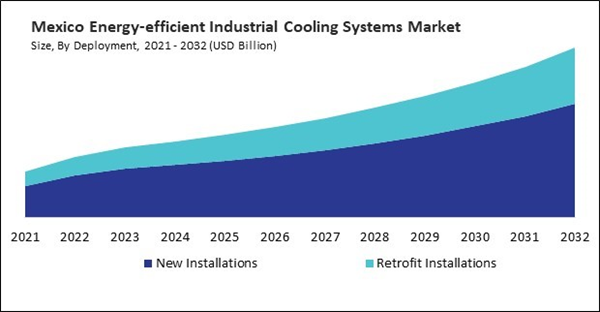The US market dominated the North America Energy-efficient Industrial Cooling Systems Market by country in 2024, and is expected to continue to be a dominant market till 2032; thereby, achieving a market value of $2.43 billion by 2032. The Canada market is experiencing a CAGR of 11.5% during 2025-2032. Additionally, the Mexico market is expected to exhibit a CAGR of 10.7% during 2025-2032.
A prominent trend reshaping the global energy-efficient industrial cooling systems market is the integration of digital and smart control systems. OEMs are embedding Internet of Things (IoT) sensors, artificial intelligence (AI), and machine learning into cooling equipment to deliver real-time monitoring, predictive maintenance, and operational analytics. Johnson Controls’ OpenBlue platform, launched in 2020, has been instrumental in enabling facilities to optimize energy consumption based on dynamic demand. Similarly, Schneider Electric’s EcoStruxure platform enhances operational efficiency by integrating AI-powered edge computing to control power loads and manage cooling needs dynamically. These technologies are being rapidly adopted in industries such as automotive manufacturing, data centers, and pharmaceuticals, where thermal stability is mission-critical.
Another transformative trend is the adoption of sustainable and low-emission cooling technologies. Rising energy prices and carbon taxation in various regions have made energy-intensive cooling systems economically unviable in the long run. Companies are responding by developing systems that employ natural refrigerants or those with low Global Warming Potential (GWP). For instance, Gradient’s 2022 release of a high-efficiency window-mounted heat pump using less potent refrigerants reflects a market-wide shift toward decarbonized, scalable cooling solutions. Trane's CenTraVac chillers, installed in energy-intensive environments like the Channel Tunnel, use low-GWP refrigerants while delivering over 30% energy savings. These examples underscore the movement toward climate-conscious cooling technologies.
The North American market for energy-efficient industrial cooling systems is shaped by a convergence of stringent energy regulations, technological innovation, and decarbonization initiatives. Across the U.S., Canada, and Mexico, industrial sectors are under increasing pressure to enhance energy productivity while reducing emissions in compliance with regulatory frameworks such as the U.S. Energy Policy Act, ASHRAE standards, and Canada’s Net-Zero Emissions Accountability Act.
List of Key Companies Profiled
- Johnson Controls International PLC
- ABB Ltd.
- Schneider Electric SE
- Trane Technologies PLC (Thermo King)
- Vertiv Group Corp.
- Daikin Industries Ltd.
- Emerson Electric Co.
- LG Electronics, Inc. (LG Corporation)
- Honeywell International, Inc.
- Fujitsu Limited
Market Report Segmentation
By Deployment
- New Installations
- Retrofit Installations
By Cooling Capacity
- 100-500 kW
- 500-1,000 kW
- >1,000 kW
- < 100 kW
By Industry
- Data Centers
- Food & Beverage
- Electronics Manufacturing
- Pharmaceuticals
- Automotive
- Food Retail
- Other Industry
By Country
- US
- Canada
- Mexico
- Rest of North America
Table of Contents
Companies Mentioned
- Johnson Controls International PLC
- ABB Ltd.
- Schneider Electric SE
- Trane Technologies PLC (Thermo King)
- Vertiv Group Corp.
- Daikin Industries Ltd.
- Emerson Electric Co.
- LG Electronics, Inc. (LG Corporation)
- Honeywell International, Inc.
- Fujitsu Limited









